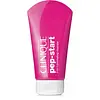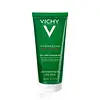What's inside
What's inside
 Key Ingredients
Key Ingredients

 Benefits
Benefits

 Concerns
Concerns

 Ingredients Side-by-side
Ingredients Side-by-side

Water
Skin ConditioningGlycerin
HumectantSodium Laureth Sulfate
CleansingSilica
AbrasiveAcrylates Copolymer
Lauramidopropyl Betaine
CleansingButylene Glycol
HumectantSucrose
HumectantCocamidopropyl Hydroxysultaine
CleansingCarica Papaya Fruit Extract
Skin ConditioningBambusa Arundinacea Stem Extract
Skin ConditioningLaminaria Saccharina Extract
Skin ProtectingSalicylic Acid
MaskingPalmitoyl Tetrapeptide-7
Skin ConditioningPalmitoyl Tripeptide-1
Skin ConditioningCaffeine
Skin ConditioningSodium Hyaluronate
HumectantAcetyl Glucosamine
Skin ConditioningSodium Coco Pg-Dimonium Chloride Phosphate
CleansingPolysorbate 20
EmulsifyingDisodium Cocoyl Glutamate
CleansingCitric Acid
BufferingSodium Cocoyl Glutamate
CleansingLaureth-2
CleansingSodium Chloride
MaskingSodium Hydroxide
BufferingSodium Sulfate
Carbomer
Emulsion StabilisingMonosodium Citrate
BufferingDisodium EDTA
EDTA
BHT
AntioxidantPhenoxyethanol
PreservativeCI 15510
Cosmetic ColorantCI 19140
Cosmetic ColorantCI 14700
Cosmetic ColorantWater, Glycerin, Sodium Laureth Sulfate, Silica, Acrylates Copolymer, Lauramidopropyl Betaine, Butylene Glycol, Sucrose, Cocamidopropyl Hydroxysultaine, Carica Papaya Fruit Extract, Bambusa Arundinacea Stem Extract, Laminaria Saccharina Extract, Salicylic Acid, Palmitoyl Tetrapeptide-7, Palmitoyl Tripeptide-1, Caffeine, Sodium Hyaluronate, Acetyl Glucosamine, Sodium Coco Pg-Dimonium Chloride Phosphate, Polysorbate 20, Disodium Cocoyl Glutamate, Citric Acid, Sodium Cocoyl Glutamate, Laureth-2, Sodium Chloride, Sodium Hydroxide, Sodium Sulfate, Carbomer, Monosodium Citrate, Disodium EDTA, EDTA, BHT, Phenoxyethanol, CI 15510, CI 19140, CI 14700
Salicylic Acid 0.5%
MaskingWater
Skin ConditioningCoco-Betaine
CleansingPropanediol
SolventPEG-120 Methyl Glucose Dioleate
EmulsifyingSodium Chloride
MaskingSodium Cocoyl Glycinate
CleansingDipropylene Glycol
HumectantZinc Gluconate
Skin ConditioningBifida Ferment Lysate
Skin ConditioningSodium Hydroxide
BufferingSodium Benzoate
MaskingPhenoxyethanol
PreservativeCopper Gluconate
Skin ConditioningCaprylyl Glycol
EmollientTetrasodium Glutamate Diacetate
Parfum
MaskingSalicylic Acid 0.5%, Water, Coco-Betaine, Propanediol, PEG-120 Methyl Glucose Dioleate, Sodium Chloride, Sodium Cocoyl Glycinate, Dipropylene Glycol, Zinc Gluconate, Bifida Ferment Lysate, Sodium Hydroxide, Sodium Benzoate, Phenoxyethanol, Copper Gluconate, Caprylyl Glycol, Tetrasodium Glutamate Diacetate, Parfum
 Reviews
Reviews

Ingredients Explained
These ingredients are found in both products.
Ingredients higher up in an ingredient list are typically present in a larger amount.
Phenoxyethanol is a preservative that has germicide, antimicrobial, and aromatic properties. Studies show that phenoxyethanol can prevent microbial growth. By itself, it has a scent that is similar to that of a rose.
It's often used in formulations along with Caprylyl Glycol to preserve the shelf life of products.
Salicylic Acid (also known as beta hydroxy acid or BHA) is a well-known ingredient for treating skin that struggles with acne and clogged pores. It exfoliates both the skin's surface and deep within the pores to help clear out buildup, control oil, and reduce inflammation.
Unlike AHAs (alpha hydroxy acids), salicylic acid is oil-soluble. This allows it to penetrate into pores which makes it especially effective for treating blackheads and preventing future breakouts.
Salicylic acid is also known for its soothing properties. It has a similar structure to aspirin and can calm inflamed or irritated skin, making it a good option for acne-prone skin that is also sensitive.
Concentrations of 0.5-2% are recognized by the U.S. FDA as an over-the-counter topical acne product.
It can cause irritation and/or dryness if one's skin already has a compromised moisture barrier, so it's best to focus on repairing that before introducing this ingredient into your routine.
While salicylic acid does not increase sun sensitivity, it’s still important to wear sunscreen daily to protect your skin.
If you are looking for the ingredient called BHA or Butylated Hydroxyanisole, click here.
Learn more about Salicylic AcidChances are, you eat sodium chloride every day. Sodium Chloride is also known as table salt.
This ingredient has many purposes in skincare: thickener, emulsifier, and exfoliator.
You'll most likely find this ingredient in cleansers where it is used to create a gel-like texture. As an emulsifier, it also prevents ingredients from separating.
There is much debate on whether this ingredient is comedogenic. The short answer - comedogenic ratings don't tell the whole story. Learn more about comegodenic ratings here.
The concensus about this ingredient causing acne seems to be divided. Research is needed to understand if this ingredient does cause acne.
Scrubs may use salt as the primary exfoliating ingredient.
Learn more about Sodium ChlorideSodium Hydroxide is also known as lye or caustic soda. It is used to adjust the pH of products; many ingredients require a specific pH to be effective.
In small amounts, sodium hydroxide is considered safe to use. However, large amounts may cause chemical burns due to its high alkaline.
Your skin has a natural pH and acid mantle. This acid mantle helps prevent harmful bacteria from breaking through. The acid mantle also helps keep your skin hydrated.
"Alkaline" refers to a high pH level. A low pH level would be considered acidic.
Learn more about Sodium HydroxideWater. It's the most common cosmetic ingredient of all. You'll usually see it at the top of ingredient lists, meaning that it makes up the largest part of the product.
So why is it so popular? Water most often acts as a solvent - this means that it helps dissolve other ingredients into the formulation.
You'll also recognize water as that liquid we all need to stay alive. If you see this, drink a glass of water. Stay hydrated!
Learn more about Water